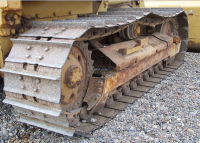








Continuous track, also called tank tread or caterpillar track, is a system of vehicle propulsion in which a continuous band of treads is driven by two or more wheels. This band is typically made of modular steel plates in the case of military vehicles, or rubber reinforced with steel wires in the case of lighter agricultural or construction vehicles. The large surface area of the tracks distributes the weight of the vehicle better than steel or rubber tyres on an equivalent vehicle, enabling a continuous tracked vehicle to traverse soft ground with less likelihood of becoming stuck due to sinking. The prominent treads of the metal plates are both hard-wearing and damage resistant, especially in comparison to rubber tyres. The aggressive treads of the tracks provide good traction in soft surfaces but can damage paved surfaces. Special tracks that incorporate rubber pads can be installed for use on paved surfaces to prevent the damage that can be caused by all-metal tracks.
Continuous tracks can be traced back as far as 1770 and today are commonly used on a variety of vehicles including bulldozers, excavators, tanks, and tractors, but can be found on any vehicle used in an application that can benefit from the added traction, low ground pressure and durability inherent in continuous track propulsion systems.
There have been theories that perhaps the oldest implementation of something resembling continuous tracks was in prehistoric erection of large stone monuments, when megaliths may have been slid atop rounded wooden logs.The logs were grooved near their ends to be held in alignment and rotation by belts out past the edge of the megalith and lubricated by some means, probably organic.The logs are carried from the back of the procession to the front in an endless chain, like continuous track. The system is a precursor to development of the axle, which keeps a rotating cylinder fixed relative to its cargo. But the logs were likely often separate and each log was carried by men from the back to the front.
In modern times, continuous track propulsion systems can be traced back to a crude continuous track system designed in the 1770s by Richard Lovell Edgeworth. Polish mathematician and inventor Józef Maria Hoene-Wro?ski conceived of the idea in the 1830s.The British polymath Sir George Cayley patented a continuous track, which he called a ""universal railway"".In 1837, a Russian inventor Dmitry Zagryazhsky designed a ""carriage with mobile tracks"" which he patented the same year, but due to a lack of funds and interest from manufacturers he was unable to build a working prototype, and his patent was voided in 1839.
Although not a continuous track in the form encountered today, a Dreadnaught Wheel or ""endless railway wheel"" was patented by the British Engineer James Boydell in 1846. In Boydell's design, a series of flat feet are attached to the periphery of the wheel, spreading the weight.A number of horse-drawn wagons, carts and gun carriages were successfully deployed in the Crimean War, waged between October 1853 and February 1856, the Royal Arsenal at Woolwich manufacturing dreadnaught wheels. A letter of recommendation was signed by Sir William Codrington, the General commanding the troops at Sebastapol.
Boydell patented improvements to his wheel in 1854 (No. 431) - the year his dreadnaught wheel was first applied to a steam engine - and 1858 (No. 356), the latter an impracticable palliative measure involving the lifting one or other of the driving wheels to facilitate turning.